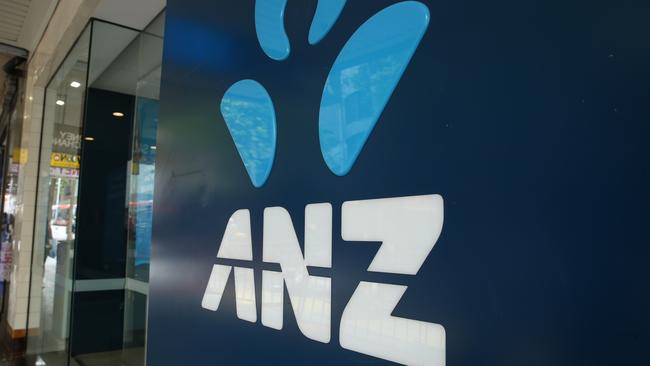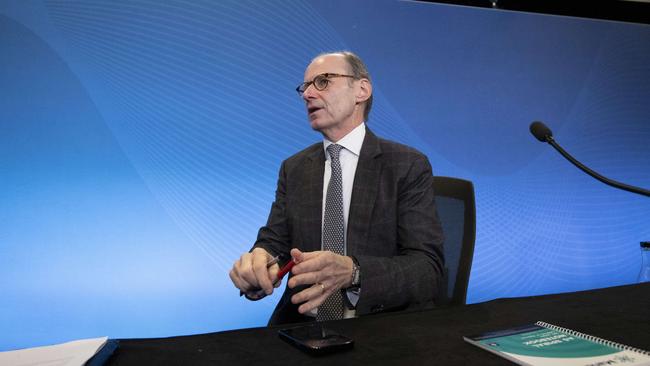ANZ now wears the big four’s ‘bad bank’ crown as APRA wades in
Even if the prudential regulator has pre-empted an investigation into ANZ’s bond trading, it believes the bank’s stumbles point to a broader trend.

Business
Don't miss out on the headlines from Business. Followed categories will be added to My News.
That ANZ has now leapfrogged Westpac to become the regulator’s enfant terrible should be a worry to the Paul O’Sullivan-led board.
The additional $250m lift to ANZ’s capital add-on outlined by bank regulator APRA forces the bank to put aside $750m in additional funds on its balance sheet to cover perceived and actual risks.
The $250m move in itself is not big but it all adds up. To put that in context, at the worst of Westpac’s and Commonwealth Bank’s offending of anti-money laundering laws, both banks were forced to carry $1bn in additional capital. ANZ is now not far behind this.
It could be argued that while ANZ’s bond trading stumbles were serious, they are not at the scale of systemic or flagrant breaches of rules quite yet. Even if the APRA boss John Lonsdale has moved too early in putting ANZ on the short leash, he argues these issues are part of a trend of poor behaviour.

An investigation by a second regulator, the Australian Securities and Investments Commission, is currently underway into ANZ around the more serious claims around potential market manipulation inside the bank’s treasury bond trading unit.
Although it is live, the very complex investigation is a long way from being finalised and it may not be until early next year an outcome is known. If that probe uncovers troubling behaviour, then that should be the trigger for APRA to throw the book at ANZ. And that would also lead to a set of whole new problems for the ANZ board.
For now, APRA is narrowing in on the two linked events inside the bank’s Sydney bond trading unit.
ANZ last month sacked several traders and supervisors in its trading team after some allegedly had come back drunk from long lunches and were out of line. Through its drawn out investigation – possibly too drawn out involving two law firms – ANZ last year stumbled on a spreadsheet error in accounting software.
That had resulted in double counting of bond transactions going back years, including giving the wrong information to Canberra’s financing arm where it had overinflated prior transaction activity, which helped it win mandates.
That’s a troubling development, but not yet equating to the systemic money laundering issues at Westpac and Commonwealth Bank, where in both cases the two banks were warned about their bad behaviour.
Lonsdale argues the capital charge is needed. ANZ’s issues raise prudential concerns and come as the bank has already fallen short in lifting its standards coming out of the Hayne banking royal commission, particularly around risk culture, governance and accountability.
Lonsdale argues the recent issues show there are still “material gaps” that need to be closed while other banks have improved their behaviour.
ANZ will now fast track work already underway on the issues raised. One way or the other, ANZ’s spending on risk and compliance is set to increase sharply in coming years.
Like trying to rebuild a reputation or win back a downgraded credit rating, it’s a slow road for a bank to having their capital penalty removed. ANZ needs to get used to it.
It took CBA almost five years to prove it has reformed its ways on governance, accountability and risk culture after its Austrac scandal. Westpac is only part way through its path back to reform. After nearly five years of being on a tighter capital leash, APRA in recent months has only knocked down Westpac’s $1bn capital penalty down to $500m.

ANZ, along with National Australia Bank, was already carrying a $500m capital add-on, coming out of 2018’s Hayne banking royal commission. Even NAB – for years the most accident prone of the big four – had all of its $500m capital impost removed early this year.
The pain of the additional capital charge directly hits investors. These could be funds otherwise lent out or sent back to shareholders. It’s a double whammy for ANZ, which is now facing the risk and management distraction of merging its newly acquired Suncorp bank.
All this is heaping additional pressure on long-term chief executive Shayne Elliott and his likely successor, the institutional boss Mark Whelan, with APRA taking its concerns directly to the ANZ board.
A negative finding or legal action coming out of the ASIC investigation will engulf both, and likely force the bank to look outside for a new chief executive.
Elliott is scheduled to appear before a parliamentary committee on August 30 as part of the standing committee into bank oversight, looking at all the big four banks. While Elliott is a seasoned witness at these sessions, the grilling coming his way is likely to be more than on the economy.
More Coverage
Originally published as ANZ now wears the big four’s ‘bad bank’ crown as APRA wades in





